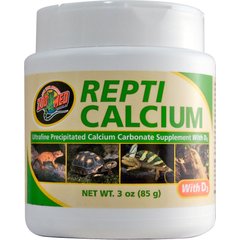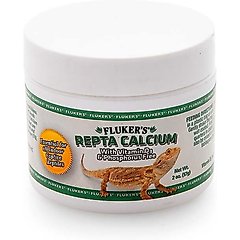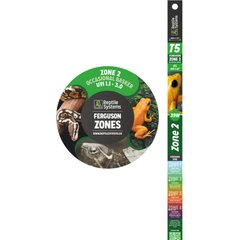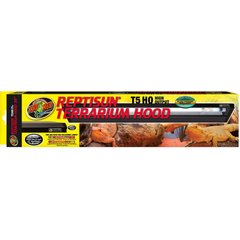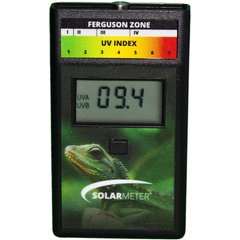Do Pet Reptiles Need UVB Lighting? What Every Reptile Owner Should Know

Photo by I am 3D animator artist/iStock / Getty Images Plus via Getty Images
Creating a great habitat for your reptile starts with learning the basics of reptile care—especially when it comes to lighting.
UVB lighting is essential for many pet reptiles, helping to prevent serious conditions like metabolic bone disease (MBD). Here’s what to know about which reptiles need UVB and why it matters.
Key Takeaways
- UVB light helps reptiles produce vitamin D3.
- Some reptiles need more UVB than others, so it's important to research your reptile's individual species.
- Use timers and meters to help ensure that your reptiles get the right amount of UVB exposure per day.
What Is a UVB Light for Reptiles?
UVB light is a specific wavelength of ultraviolet light produced by the sun. It helps reptiles produce vitamin D3, which is critical for processing calcium and preventing MBD and other health issues.
“It’s the same stuff that we need in order to produce vitamin D in our skin. Reptiles need that as well,” explains Denise Cieri, founder of HerpHaven Reptile Rescue and Sanctuary in Brunswick, Maine.
Reptiles need vitamin D3 to process and use the calcium provided in their diet and supplements, like Zoo Med Repti Calcium with D3 Reptile Supplement and Fluker’s Calcium with Vitamin D3 Indoor Reptile Supplement. Without calcium, phosphorous, and D3, sun-loving reptiles like bearded dragons and uromastyx struggle to develop strong bones.
Recommended Products
Reptiles cannot get enough D3 from supplements and may end up with deformed legs, spinal problems, and more. Once the deformities begin forming, they cannot be fixed.
Which Pet Reptiles Need UVB Light?
Any diurnal reptile (reptiles who spend their waking hours during the day in the sun) needs UVB light, says Jennifer Ramsey, founder and CMO of Creepy Critters Rescue in Los Banos, California.
Crepuscular and nocturnal reptiles may benefit from a little UVB but don’t need it for survival.
Reptiles With Low-Level to No UVB Light Needs
Ramsey says animals that are whole-prey eaters such as snakes and many monitors do better without UV than animals that are not whole-prey eaters. These reptiles include:
- Crested gecko
- Leopard gecko
- Burmese python
- Australian water dragon
- California kingsnake
- Ball python
- Axolotl
- Woma python
- Green tree python
Reptiles With Mid-Level UVB Needs
These reptiles get a lot of sun but also move back and forth between basking and shade, often spending significant amounts of time in the sun:
- Black-headed python
- Parson’s chameleon
- African spurred tortoise
- Panther chameleon
- Bearded dragon
- Tegu
- Kimberley rock monitor
- Lace monitor
Reptiles With High-Level UVB Needs
The strongest of all UVB lights are reserved for species that spend a significant time every day basking in the sun, including:
- Most agama species
- Chuckwalla
- Most uromastyx species
Check your pet reptile’s species needs and set up your lighting accordingly.
Even though most snakes do very well without UVB, “every now and then, if we get a snake that has a respiratory infection, we will throw UV light on them to help them heal,” says Ramsey.
What Happens When a Reptile Doesn’t Get Enough (or Too Much) UVB?
Keeping your reptiles healthy requires a balance of habitat, nutrients, and UVB light. Without enough UVB light, reptiles can suffer from a variety of illnesses:
- Lethargy, poor appetite, stunted growth are often the first signs of a lack of UVB.
- MBD most commonly affects lizards, turtles, and tortoises, causing their bones to become weak and rubbery, making them prone to fractures. MBD takes months to develop and can be fatal if untreated. Any deformities that occur are permanent.
- Organ damage can happen when a reptile doesn’t receive enough UVB for long periods of time, usually because they also don’t produce enough D3. This vitamin is used throughout the body to maintain body functions, like liver and kidney function, cell division, and immune function.
- Behavioral issues and stress-related problems are common when the body isn’t getting what it needs to thrive.
“Be really prepared and pay attention to your pet, “Ramsey says. “If your pet is avoiding the bulb, the strength might be too high.” On the other hand, Ramsey explains that if they’re lethargic and not eating, the strength is probably too low.
Can Reptiles Get Sunburn?
Just like you, spending too much time in the sun can give your pet reptile a sunburn. In lizards like bearded dragons, they may keep their eyes closed most of the time and may even develop photokeratitis, a painful condition caused by too much UVB exposure. Always be sure your scaly pal has a way to get out of the sun.
Cieri explains that while companies are working on the problem, there are no reptile-approved LED UVB bulbs. A reptile pet parent’s best bet is to use linear T5 or T8 bulbs from reputable companies like Reptile Systems.
Recommended Products
How To Provide Proper UVB Lighting
Before you purchase any equipment, study your pet reptile’s species needs carefully. Consult several sources, including a veterinarian with extensive experience with your species.
While you’re getting your reptile habitat set up, consider including a solar meter in your list. They can be a little pricey but are useful if you have many reptile enclosures. Bulbs can last longer than the manufacturer’s recommended time, but without accurate measurements, there’s no way to tell.
Yet when you only have one or two reptiles, a meter may not be worth the money—you’re only going to use it a couple of times per year. Ramsey says that it’s just as easy to put a new bulb in with a piece of masking tape on the fixture and date it the week before it needs to be replaced.
Types of UVB Bulbs and Strengths
UVB lights come in a few different shapes, styles, and strengths. Choosing the right one depends on the fixture you have and how much UVB your reptile needs:
- Linear bulbs (T5 or T8 designations refer to the fixture) look like a regular fluorescent tube-shaped bulb. They are very effective and can last a full year.
Recommended Product
- Coil CFL UVB lights are compact and inexpensive but must be replaced every four to six months.
- Mercury vapor bulbs provide heat and light and last up to 18 months.
Before choosing a bulb, determine the lighting your reptile pet would have in the wild, and consider the enclosure size. The taller the enclosure, the farther away the bulb will be from basking areas.
UV bulbs also have strength ratings—the higher the number, the more UVB light (stronger UV index) it will produce.
Use timers and meters, like the Solarmeter Model 6.5R UV Index Meter, to help ensure that your reptiles get the right amount of UVB exposure per day. You can also use them to replicate a day/night cycle.
Recommended Product
“They still need to know if it’s day or night, even if you have a fully nocturnal species,” says Cieri.
Note: Mesh screens can filter up to 40% of the UV light produced. Make sure that the light is not blocked by plastic or glass—they filter UV light, making your lights useless.
Common Myths and Misconceptions About UVB Lighting for Reptiles
Despite developments in reptile husbandry and advances in technology, a few myths and misconceptions continue to mislead reptile pet parents.
“I put my reptile cages in sunny windows so they’ll get enough UV light.”
Wrong. Cieri explains that UV light does not travel through glass or plastic. Plus, the enclosure can get very hot, turning their home into an oven.
“Calcium supplements make UVB unnecessary.”
Think again. While reptiles can get most of their calcium from a supplement, it’s more effective and healthier for the reptile to provide the UVB light their body needs.
“All reptiles need the same type of light.”
Not true! Reptiles need varying amounts of UVB light, depending on where they exist in the wild. For example, a shade-dwelling frog doesn’t need as much as a bearded dragon.
Final Tips and Best Practices
Reptile husbandry is as much science as it is art. You need to know your pet reptile’s needs, provide for them, and be willing to change things up when something isn’t working.
Here are a few tips to help you get started:
- Know your species. The reptiles we keep as pets come from a wide range of habitats—some originate in deep, dark jungles, while others made their home in the middle of a burning desert. Spend time learning as much as you can about your reptile pets so you can provide the best possible home.
- Monitor behavior and health. Many health problems first appear as a behavior problem. If your scaly friend is displaying odd behavior, it may be time for a vet appointment.
- Provide proper UVB lighting, give your reptile pet a balanced diet and supplements, and ensure proper temperatures. Keeping your reptiles and amphibians healthy means balancing their needs. Without proper lighting they can’t process calcium, and without the right temperatures, they can’t digest their food.
- Consult with a vet experienced with exotic pets. Your setup can make or break your reptile’s health. Have access to a great veterinarian who can review your lighting and setup. Not all exotic vets have this experience, so ask first.
By understanding and delivering the right balance of UVB, heat, and nutrition, you’ll set your reptile up for a life of strength, vitality, and natural behaviors. It’s one of the most important—and rewarding—parts of reptile care.
FAQs About UVB Light for Reptiles
What is the difference between UVB and UVA for reptiles?
While UVB is a requirement for vitamin D3 production, UVA can help them regulate their circadian rhythms to sleep when it’s time to sleep, and vice versa.
Why is UVB light important for reptiles?
UVB helps reptiles produce vitamin D3, critical for processing calcium and preventing MBD and other health issues.
Is too much UVB bad for reptiles?
Yes! Just as with humans, a reptile’s skin and eyes can be damaged by too much UVB.
Are reptile UVB lights safe for humans?
They are safe for humans. It’s the same wavelength that we get from the sun.
How long do reptile UVB lights last?
It depends on the brand, but most last at least six months before the UV index begins to drop off.
Do nocturnal reptiles need UVB?
Unless they’re cave-dwelling reptiles that never see the sun, even nocturnal reptiles can benefit from UVB exposure by having a day/night cycle and even utilizing some of the UVB.
